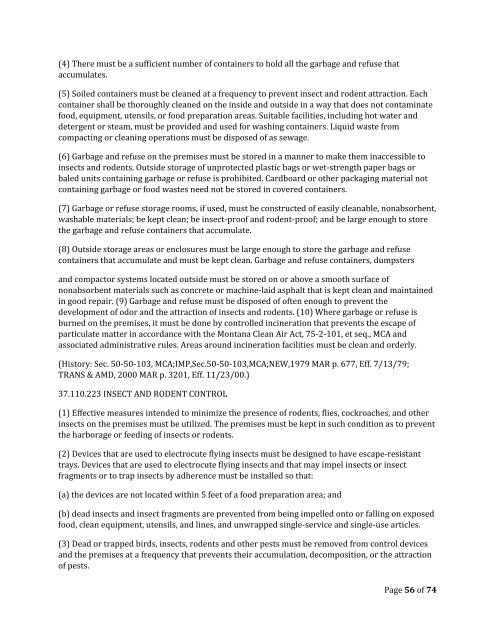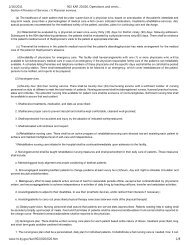State Regulations Pertaining to Dietary Sanitation & Environmental ...
State Regulations Pertaining to Dietary Sanitation & Environmental ...
State Regulations Pertaining to Dietary Sanitation & Environmental ...
You also want an ePaper? Increase the reach of your titles
YUMPU automatically turns print PDFs into web optimized ePapers that Google loves.
(4) There must be a sufficient number of containers <strong>to</strong> hold all the garbage and refuse that<br />
accumulates.<br />
(5) Soiled containers must be cleaned at a frequency <strong>to</strong> prevent insect and rodent attraction. Each<br />
container shall be thoroughly cleaned on the inside and outside in a way that does not contaminate<br />
food, equipment, utensils, or food preparation areas. Suitable facilities, including hot water and<br />
detergent or steam, must be provided and used for washing containers. Liquid waste from<br />
compacting or cleaning operations must be disposed of as sewage.<br />
(6) Garbage and refuse on the premises must be s<strong>to</strong>red in a manner <strong>to</strong> make them inaccessible <strong>to</strong><br />
insects and rodents. Outside s<strong>to</strong>rage of unprotected plastic bags or wet-strength paper bags or<br />
baled units containing garbage or refuse is prohibited. Cardboard or other packaging material not<br />
containing garbage or food wastes need not be s<strong>to</strong>red in covered containers.<br />
(7) Garbage or refuse s<strong>to</strong>rage rooms, if used, must be constructed of easily cleanable, nonabsorbent,<br />
washable materials; be kept clean; be insect-proof and rodent-proof; and be large enough <strong>to</strong> s<strong>to</strong>re<br />
the garbage and refuse containers that accumulate.<br />
(8) Outside s<strong>to</strong>rage areas or enclosures must be large enough <strong>to</strong> s<strong>to</strong>re the garbage and refuse<br />
containers that accumulate and must be kept clean. Garbage and refuse containers, dumpsters<br />
and compac<strong>to</strong>r systems located outside must be s<strong>to</strong>red on or above a smooth surface of<br />
nonabsorbent materials such as concrete or machine-laid asphalt that is kept clean and maintained<br />
in good repair. (9) Garbage and refuse must be disposed of often enough <strong>to</strong> prevent the<br />
development of odor and the attraction of insects and rodents. (10) Where garbage or refuse is<br />
burned on the premises, it must be done by controlled incineration that prevents the escape of<br />
particulate matter in accordance with the Montana Clean Air Act, 75-2-101, et seq., MCA and<br />
associated administrative rules. Areas around incineration facilities must be clean and orderly.<br />
(His<strong>to</strong>ry: Sec. 50-50-103, MCA;IMP,Sec.50-50-103,MCA;NEW,1979 MAR p. 677, Eff. 7/13/79;<br />
TRANS & AMD, 2000 MAR p. 3201, Eff. 11/23/00.)<br />
37.110.223 INSECT AND RODENT CONTROL<br />
(1) Effective measures intended <strong>to</strong> minimize the presence of rodents, flies, cockroaches, and other<br />
insects on the premises must be utilized. The premises must be kept in such condition as <strong>to</strong> prevent<br />
the harborage or feeding of insects or rodents.<br />
(2) Devices that are used <strong>to</strong> electrocute flying insects must be designed <strong>to</strong> have escape-resistant<br />
trays. Devices that are used <strong>to</strong> electrocute flying insects and that may impel insects or insect<br />
fragments or <strong>to</strong> trap insects by adherence must be installed so that:<br />
(a) the devices are not located within 5 feet of a food preparation area; and<br />
(b) dead insects and insect fragments are prevented from being impelled on<strong>to</strong> or falling on exposed<br />
food, clean equipment, utensils, and lines, and unwrapped single-service and single-use articles.<br />
(3) Dead or trapped birds, insects, rodents and other pests must be removed from control devices<br />
and the premises at a frequency that prevents their accumulation, decomposition, or the attraction<br />
of pests.<br />
Page 56 of 74



